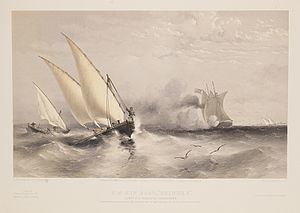Name HMS Grinder Laid down 13 October 1854 Construction started 13 October 1854 Weight 288.6 tons Draft 1.83 m | Ordered 6 October 1854 Commissioned 17 May 1855 Launched 7 March 1855 Displacement 257,600 kg | |
 | ||
Builder J & R White, West Cowes Cost Hull £4,084, machinery £3,567 | ||
HMS Grinder was a wooden 3-gun Dapper-class gunboat, launched on 7 March 1855. Although she served for nine years, her most active period was in her first year when she served in the Crimean War.
Contents
Black Sea and Sea of Azov
During the summer of 1855, Grinder carried out raids on Russian food and ammunition stores to prevent supplies reaching the Russian troops in the Crimea. Grinder and nine other gunboats (Beagle, Boxer, Cracker, Curlew, Fancy, Jasper, Vesuvius, Swallow and Wrangler ) were employed destroying fisheries and corn stores, as well as ammunition stores, around the Sea of Azov. Their raids forced the Russian land forces to maintain a state of constant readiness lest there be a landing.
The British naval squadron, including Grinder, was active on 23 September 1855 at the entrance to the Sea of Azov in destroying communications between Temryuk and Taman, an area of shallow seas, swamps and bridges.
For some of this summer period, Grinder, under the command of Lieutenant Francis Trevor Hamilton, served as a tender to the first rate Royal Albert, flagship of Rear Admiral Sir Edmund Lyons, Bart GCB.
From July 1855 she was commanded by Lieutenant Burgoyne. Grinder played her small part in the actions against the fort at the head of Dnieper Bay as part in a joint force of British and French warships, including the steam frigate Valourous, Gladiator and Clinker, on 18 October 1855.
Further activities of the squadron, including Grinder, consisted of destroying vast quantities of provisions and fuel near the town of Yeisk in the Sea of Azov on 3 November 1855, just as the weather was changing to make naval activities there impossible. The attacks were on such a broad front that even the presence of 1500 cossacks in the area did not inconvenience the landing parties.
Fate
Grinder was decommissioned in 1864, and broken up at Portsmouth.
